Sommaire
Top 5 Vintage Watches Under €500 to Start Your Collection
What if the key to a legendary watch collection was hiding in your uncle’s dusty drawer, for less than €500? Too good to be true? Not if you know where to look.
Behind the flashy luxury showcases, Seiko 5s, Timex Marlins, Orient Crystals, Lip Nautic-Skis, or Vostok Amphibias still tick discreetly, their noble patina whispering: “I have passed through hands, storms, and revolutions.”
So, before the next wave of hype propels them out of reach, let me guide you into a universe where the hacking second is no longer a privilege, where Hesalite crystal takes on amber hues, and where each caliber earned its stripes in the field rather than in a boutique.
Imagine the satisfaction of strapping an authentic piece of history to your wrist, time-tested and accessible without a loan. Remember, truly affordable vintage is becoming rare: those who know, act; the others watch prices soar. Don’t wait for the latest TikTok hype to snatch up the last good deals: turn the page, discover these five hidden icons, and finally treat yourself to the first heartbeat of a collection that reflects you.
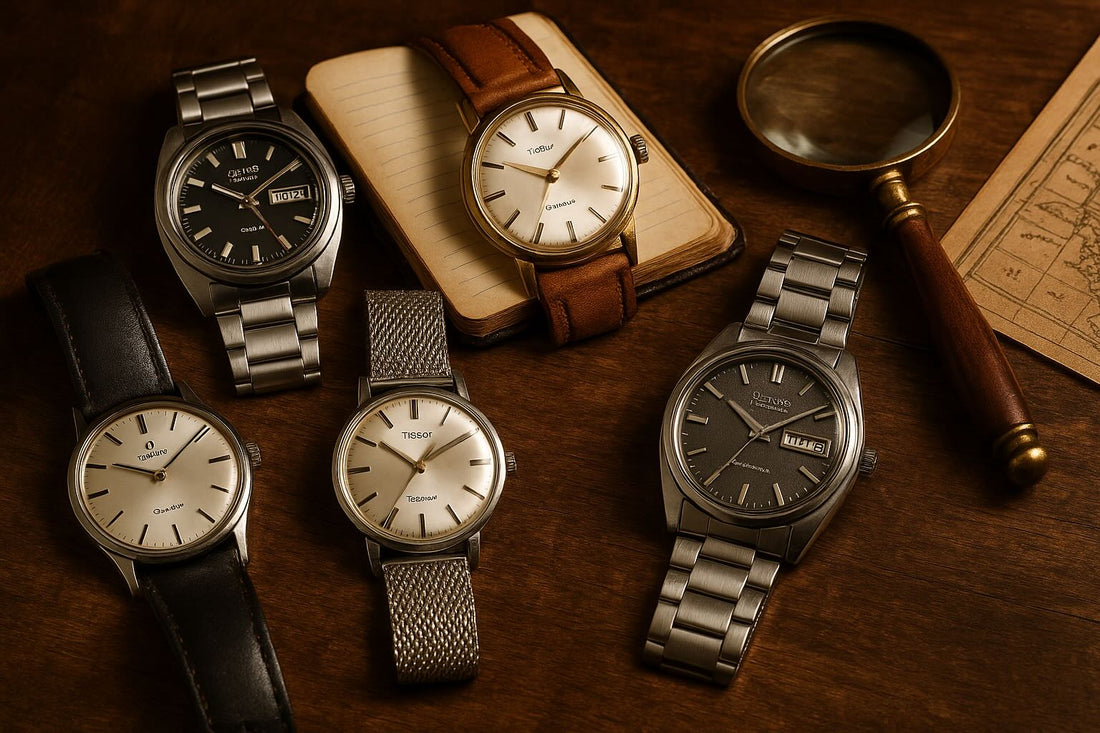
1. Seiko 5 (1960s-70s) – The Democratized Automatic
Historical Context and Revolution: In 1963, Seiko launched the Seiko Sportmatic 5, Japan’s first automatic day-date watch. With it, Seiko achieved a masterstroke: offering a mechanical watch that was robust, precise, and affordable, at a time when these combined qualities were rare.
The « 5 » in Seiko 5 refers to the five key features of the concept: an automatic movement with bidirectional winding via a rotor (the famous patented Magic Lever), day and date display in a single window (an ergonomic innovation for the time), improved water resistance, a recessed crown at 4 o’clock (for comfort and to signify no need for winding), and an ultra-resistant case and bracelet.
When Seiko introduced these watches in the mid-1960s, Swiss competitors struggled to offer such complications on entry-level models. By democratizing reliable automatic movements, Seiko disrupted the market and captured the wrists of an entire generation of young professionals and students, from Japan to the United States and Europe.
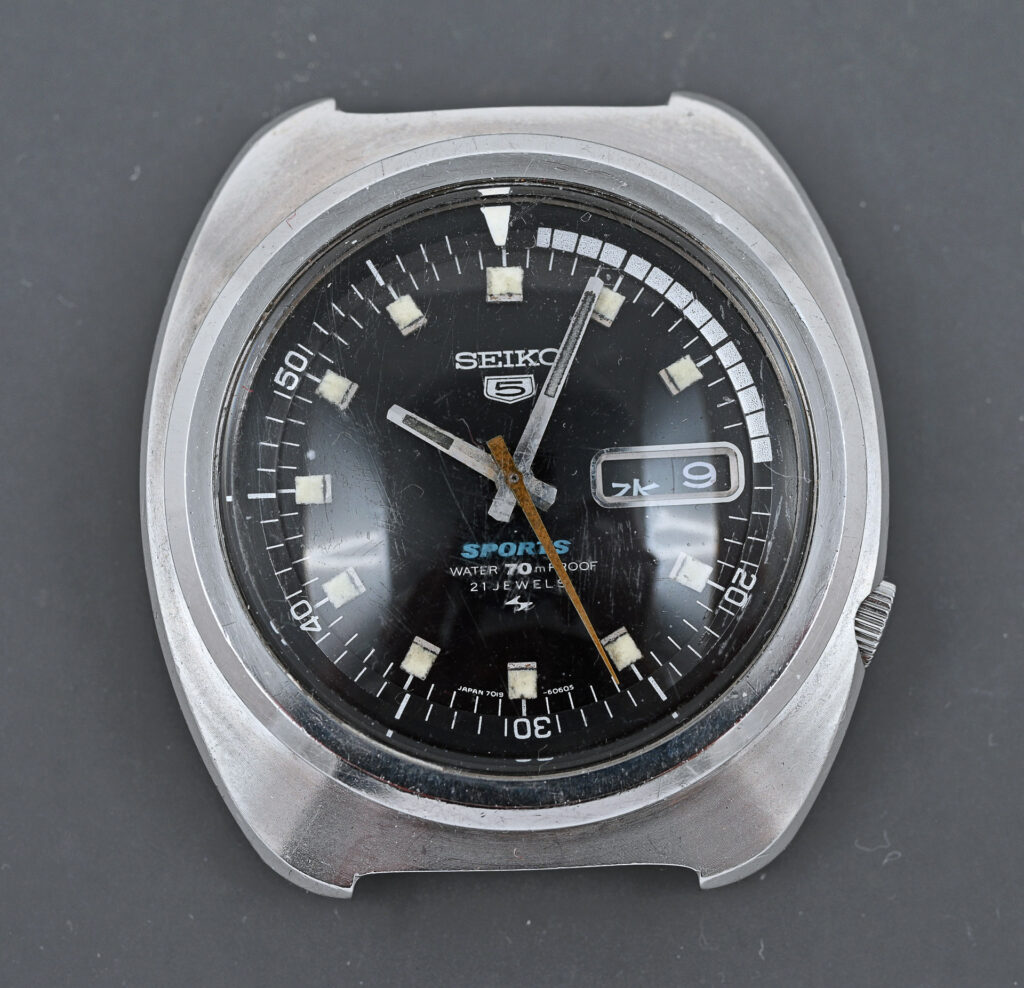
Movement and Complications: The Seiko 5 houses, depending on the version, in-house automatic calibers such as the 61xx, 63xx, or 7S series (in later generations). For example, the 21-jewel caliber 6119 from the 70s beats at 21,600 vph and includes an ingenious quickset date feature for the era. Seiko focused on functional simplicity: no extravagant complications, just the essentials: hour, minute, sweeping second hand, day, and date.
Everything is protected by an often monobloc steel case, ensuring good water resistance (typically 30 to 70m depending on the model). The Seiko 5 popularized the use of the Diashock (anti-shock) system and the unbreakable Diaflex mainspring, ensuring the movement’s longevity. Designed to never stop as long as worn (hence the offset crown, almost symbolically « forgotten »), these watches proved that quality mechanics could be mass-produced at low cost.
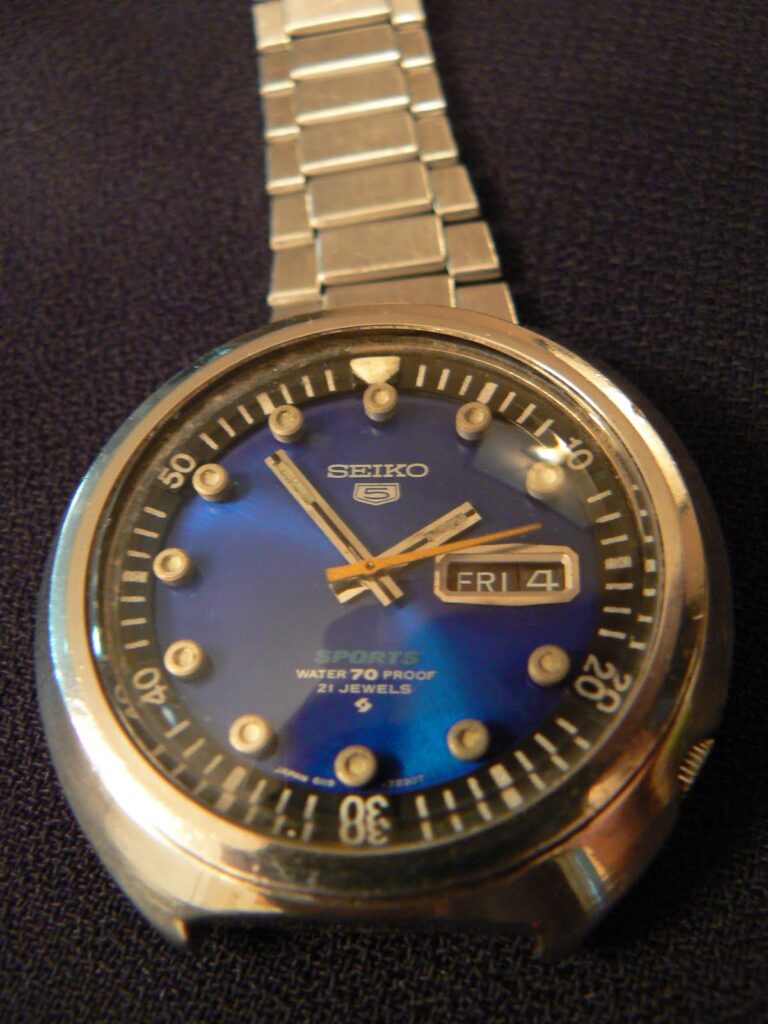
Must-Have References: The Seiko 5 range is prolific, but a few cult references are sought after by budding collectors. The original Seiko 5 Sportsmatic from 1963, of course, but also the numerous Seiko 5 Sport variants from the 70s with a « diver » look (internal bezel graduated 0-60, vibrant sunburst dials in blue, green, etc.). Examples include the Seiko 6119-8160 « Rally Diver » with its distinctive rally-style inner bezel, or the Seiko 5126-6010 « Sports 70m » worn by soldiers during the Vietnam War.
Later, series like the Seiko 7009 or 7S26 (80s-90s) continued the Seiko 5 spirit. The advantage is the huge variety of styles (sober black dials, flashy gold ones, square 70s cases, etc.) while maintaining the same mechanical philosophy. Every beginner collector can find « THEIR » Seiko 5 that speaks to them aesthetically, without fear of making a poor technical choice – they are all reliable.
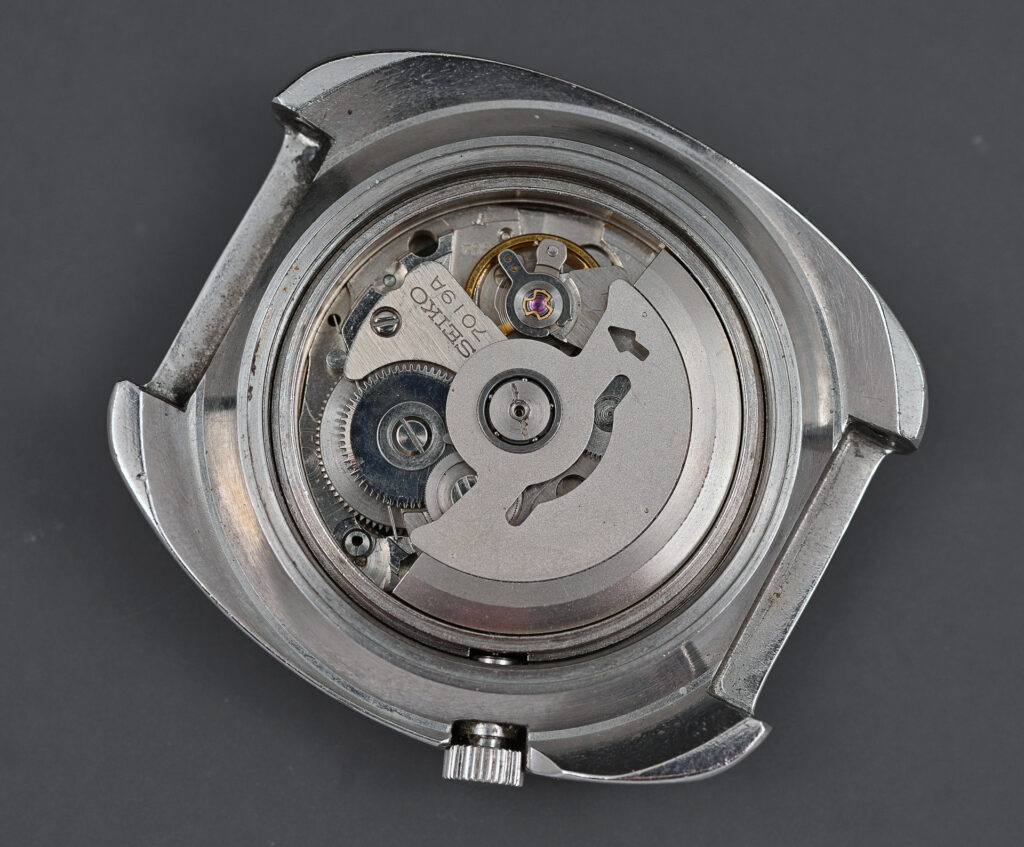
Price Evolution (2025): Good news for beginners: Seiko 5 vintage watches remain among the most affordable old watches on the market. Simple models from the 70s in good working condition can be found starting from €50 to €150 on auction platforms or forums, a price almost unchanged for a decade despite the vintage craze.
Only very specific references or those in « New Old Stock » condition (never worn) might exceed €200-€300. This means that in 2025, the Seiko 5 stays true to its original spirit: offering a real quality mechanical watch at a democratic price. For example, a Seiko 5 Sports « Regatta » with an internal bezel, which cost about fifty dollars in the 70s, now trades for around €100-€120 – a reasonable value that even allows acquiring several to vary the pleasures.
Discover the Seiko 5s available on Catawiki (perfect for unearthing vintage gems).
Coherent Alternative: If the aesthetics or modest size of the Seiko 5 doesn’t suit you, take a look at vintage Citizen Automatic watches from the 70s (Seven Star or Crystal 7 series). Citizen then offered watches similar in spirit – automatic, day-date, 70s design – often just as reliable and in similar budget ranges in 2025 (often under €200). A Citizen Seven Star « Day-Date », for example, offers a credible Japanese alternative to the Seiko 5 for starting a collection.
2. Timex Marlin (1960s-70s) – All-American Tough Elegance
Historical Context and Revolution: « It takes a licking and keeps on ticking. » This Timex advertising slogan from the 50s-60s perfectly summarizes the philosophy of the American brand.
The Timex Marlin embodies this era when Timex succeeded in democratizing the mechanical watch in the United States and beyond. In the 1960s, while Swiss watches dominated in prestige, Timex – heir to the Waterbury Clock Co. – flooded the market with simple, inexpensive, but reliable mechanical watches.
The Marlin, launched in the late 1950s, is a small manual wind dress watch (~34mm), with a sober design (silvered or champagne dial, Arabic numerals or stick indices depending on variants).
Why is it revolutionary? Because Timex proved that a mechanical watch could be produced almost like a common consumer item, thanks to manufacturing innovations and bold marketing. For example, Timex used a pin-lever escapement without jewels, less expensive than the traditional anchor escapement. This « cheap & tough » movement was assembled on the line but sufficiently precise for daily use.
Above all, Timex dared extreme demonstrations (the famous televised Torture Tests with John Cameron Swayze) where watches were seen strapped to a baseball bat during a game or frozen in an ice cube – emerging intact. This cemented the idea that « Timex » = indestructible in the public mind. By making the wristwatch as commonplace as a pen, Timex converted an entire population to everyday watch-wearing.
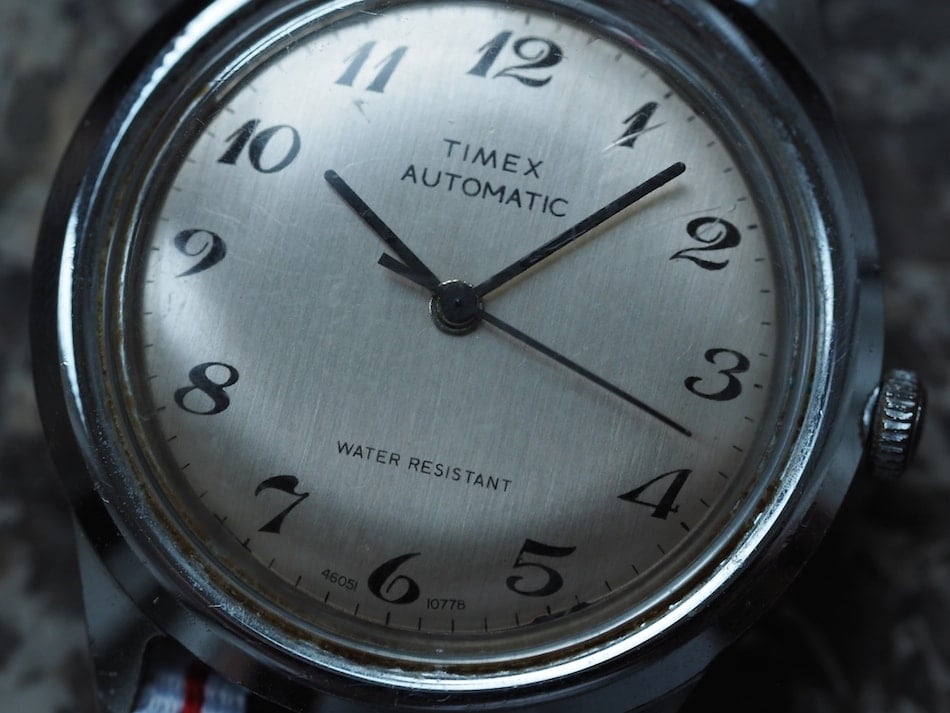
Movement and Features: Most vintage Timex Marlins house a Timex manual 17-jewel caliber or a jewel-less pin-lever variant. For example, a studied 1978 Marlin featured a caliber with no jewels at all: an all-brass « pin-lever » escapement, running at ~18,000 vph and offering a 36-40 hour power reserve.
The absence of jewels (which reduce friction) might suggest rapid wear, but Timex designed these calibers to be highly serviceable: few parts, easy to replace, and minimalist lubrication. If necessary, the entire movement block could be swapped for a few dollars – it was the « disposable » watch before its time, although many have survived 50 years without issue.
These movements generally have no complication other than the central second hand and sometimes the date (some later Marlins are automatic date). The classic Marlin is « Water Resistant » (meaning splash-resistant, thanks to a back gasket), housed in a chrome-plated case (plated brass) with a snap-on steel back. The crystal is domed plexiglass, giving it an adorable curved profile.

In hand, a vintage Timex can feel more crude than a Seiko 5 – stamping marks are sometimes visible inside the case, the crown isn’t waterproof, etc. But this manufacturing honesty also constitutes its rustic charm. Design-wise, the Marlin displays a sober American elegance: no frills, a clean dial (often sunburst champagne or silver, simply inscribed with « TIMEX » and « Waterproof » or « Water Resistant »). Ironically, this minimalist style makes it very desirable today, evoking the Mad Men aesthetic of the 60s.
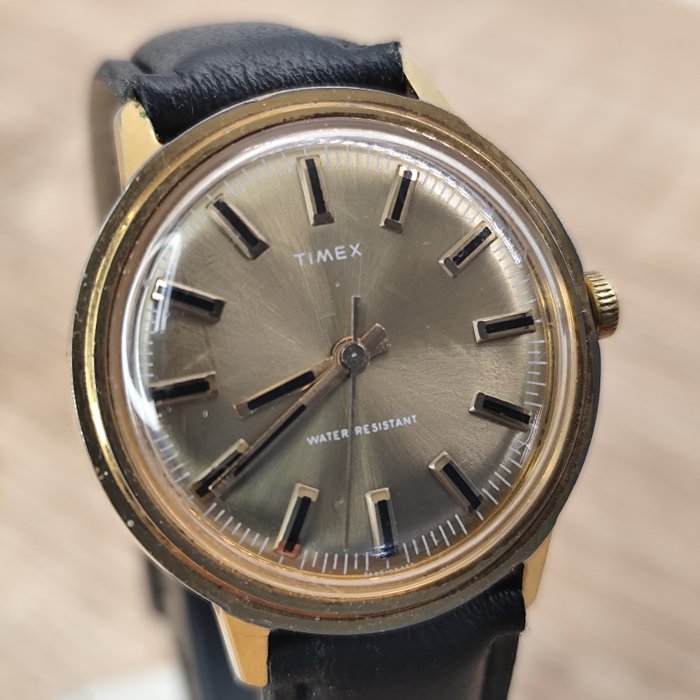
Must-Have References: With vintage Timex, we speak less of precise references (Timex codes are complex) and more of series: the Marlin is the best-known manual mechanical. There are Marlin Automatics variants (70s) that are slightly larger (36mm) and equipped with a rotor. The Viscount is an even dressier Timex (automatic date caliber, cushion case). For a military style, the Timex Mercury or Sprite from the 70s offer 24-hour « field watch » type dials.
Of course, Timex produced other icons – the unbreakable V-Conic, the later digital Ironman – but for the beginner vintage collector, the Marlin remains THE classic to own, symbolic of popular American watchmaking. It can be found either in a retro Arabic numerals version (notably the early 60s Marlins with beautiful rounded fonts) or in a more modern stick indices version. Both are worth checking out. A tip: prioritize dials marked « Waterproof » (before 1968) or « Water Resistant » (after US standards of 1968) to be sure it’s an original model from the era.
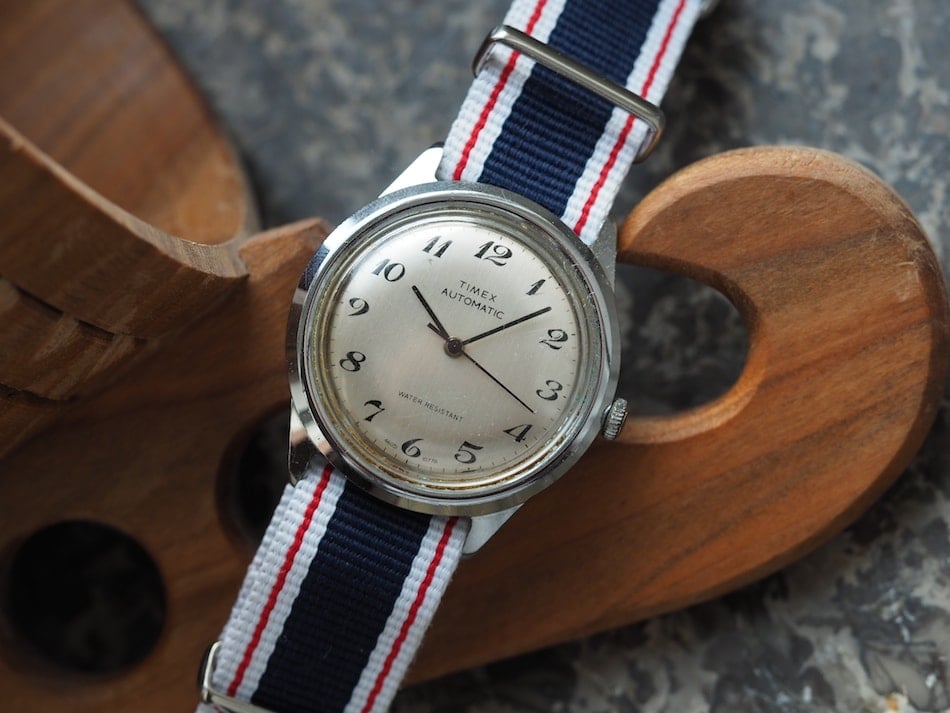
Price Evolution (2025): Vintage Timex mechanical watches were long snubbed by collectors, which explains why in 2025, their prices remain very gentle. A standard 1960s Timex Marlin in good cosmetic condition but possibly needing a service can be found for around €50 to €100. Even an impeccable example rarely exceeds €150.
The recent re-release of the Marlin by Timex (2017) has brought the historic model back into the spotlight, but paradoxically, the vintage is still easier to find than the new one! Moreover, having been produced in millions, old Timex watches abound on the second-hand market (eBay is full of Marlin listings around $80-$120). However, beware of unscrupulous sellers who sometimes try to ride the vintage wave to inflate prices: let’s not forget these were originally watches produced for ~$15 (admittedly, new-in-box examples are rare and can reach €200-€300 among very keen collectors).
Overall, the Timex is the quintessential vintage watch for a small budget – its value increases slowly but surely, without speculative bubbles, allowing it to still be purchased at a reasonable price and potentially resold at the same price or slightly higher in a few years.
Find your Timex Marlin on Catawiki (interesting auctions for these American classics).
Coherent Alternative: As an alternative to the Timex, one might look towards French mechanical watches from the 60s. For example, a manual-wind Lip Himalaya – worn by mountaineer Maurice Herzog in 1950 – offers equivalent reliability and style (35mm steel or gold-plated case, nice simple dial) for prices ranging from €100 to €300 depending on condition. Similarly, vintage Bulova (Mechanical or Sea King range) or Caravelle (Bulova’s sub-brand) from the sixties are often found under €200. They usually feature robust Swiss A. Schild movements and a « Mad Men » look very close to the Timex, while being slightly higher-end in finish.
3. Orient (1960s-70s) – All-Around Japanese Creativity
Historical Context and Revolution: Less known to the general public than Seiko or Citizen, the Japanese brand Orient has nevertheless also marked watchmaking by making certain complications and bold designs accessible. In the 60s, Orient Watch Co. was booming: recently independent again (after its revival in 1950), the manufactory in Hino (Tokyo) sought to stand out through innovation and export. In 1965, it launched the first Orient King Diver (40m then 200m diver) to ride the demand for sports watches, then in 1967 the Orient Fineness, equipped with the world’s thinnest automatic day-date caliber at the time (only 3.9mm thick). These models were revolutionary because Orient, smaller than Seiko, was not afraid to innovate in niches: the thinnest, the first Japanese compressor, etc.
Above all, Orient embraced a very original style for the era, targeting the international market. For example, the famous Orient Jaguar Focus (1970) featured an emerald green and gold dial with a roaring jaguar in advertising – an aesthetic both luxurious and exuberant to capture attention for export.

Movement and Complications: Orient has manufactured its own movements from the beginning, and in the 60s-70s, we mainly find the 469 caliber and its derivatives (automatic caliber with 21 jewels and 21,600 vph, with day-date) – a movement so successful it would still equip contemporary Orient watches into the 2000s. The 1967 Orient Fineness, on the other hand, introduced the extra-thin 3900 caliber (3.90mm) thanks to an architecture tightening the gear train: it was a technical feat for an automatic day-date of the time.
On the complications side, Orient shone with its series of Annual Calendar (Multi-Year Calendar) watches from 1965: a dial displaying a perpetual calendar over several years, a truly useful and playful complication, revived in 1976 and then in modern Orients. Orient divers (King Diver, Weekly Auto Orient Diver) featured internal rotating bezels, and some Chrono Ace versions (1970) even integrated a mechanical depth gauge on the dial – yes, an immersion depth indicator, extremely rare on a wristwatch! As you can see, Orient dared technical specificities that its direct competitors did not have in this price segment.
From a design perspective, a vintage Orient is recognizable by a few charming details: the inscription « Orient ★ Crystal » or « AAA » on some 21-jewel dials, the logo with two facing lions holding a crowned O, vibrant colors (gradient « smoky » dials in orange, petrol blue, etc.), and often original date windows (position at 4 o’clock, etc.). A vintage Orient is often a bit bolder than a Seiko from the same era: the brand targeted a young clientele eager for modernity.
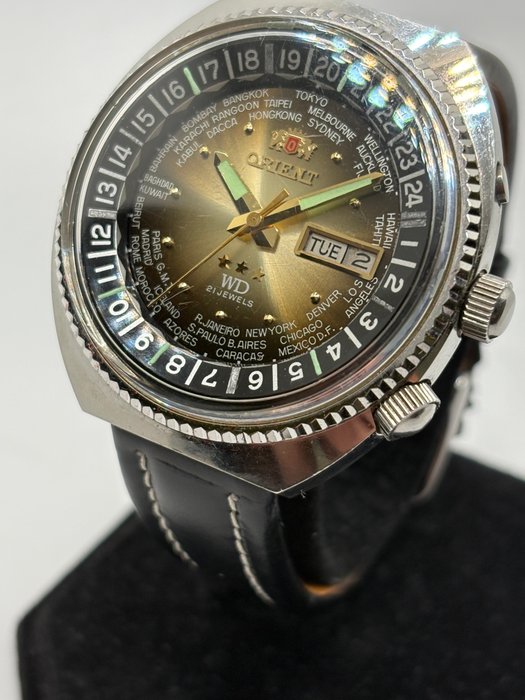
Must-Have References: Among the collectible vintage Orients are: the famous Orient *Weekly Auto King Diver*** (1965-69) – a 42mm automatic day-date super-compressor diver that rivaled Seiko Divers, now rare and valued around €1000 in perfect condition (Orient actually reissued it in 2020).
More accessible, the multiple versions of the **Orient *3 Stars*** (or *Tri-Star*, unofficial name for models marked with three stars on the dial) from the 70s offer a dressy or sporty style with the reliable 469 caliber: they are somewhat the « Seiko 5 of Orient, » still easily found under €100. Examples include the widespread Orient **Crystal 21 Jewels**, or the Orient *Galaxy* with its shooting star-shaped second hand.
For lovers of original pieces, the **Orient *Multi-Year Calendar*** with its information-packed dial (days, months, calculated years) is a nice must-have – a 1976 model can be found for around €200-€250. Finally, in the realm of elegance, the **Orient *Grand Prix 100** (1964, for the 100th anniversary of watchmaking in Japan) offers a manual 19-jewel movement in a thin, often engraved gold case, which can still be found around €300-€400.
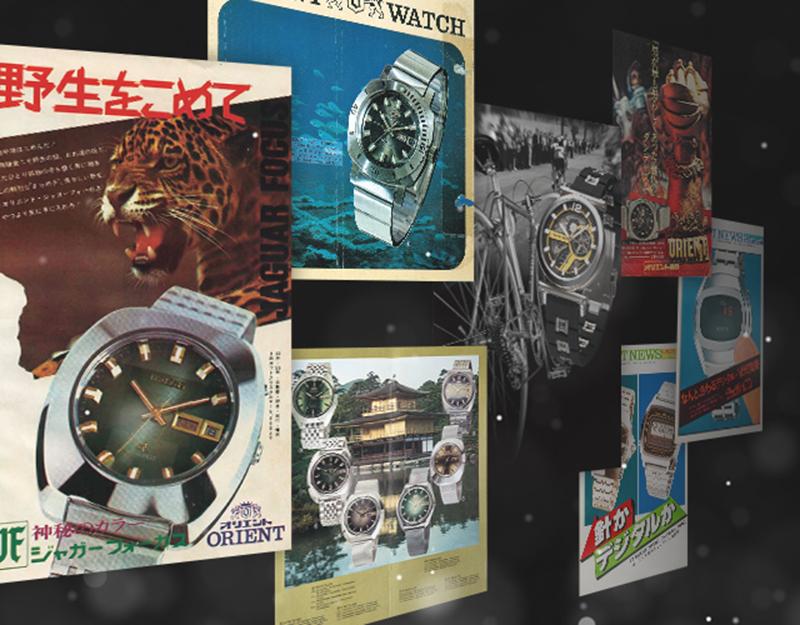
Price Evolution (2025): Vintage Orients probably offer the best value for money in the old watch market today. Many models (excluding very specific collector’s items) remain priced below €100! For example, one can buy a 1970s Orient Three Star in decent condition for €50-€80. Demand for these watches has certainly increased (fueled by the very active Orient community on forums), but supply remains abundant.
Only mythical references like the King Diver or certain Orient chronographs (very rare) see their prices soar beyond €500. In 2025, it’s even observed that vintage Orients are undervalued compared to equivalent Seikos: partly due to lack of notoriety, partly because the brand was absorbed by Seiko Epson in 2017 (which reassures about parts availability).
Thus, for a beginner collector, it’s an ideal hunting ground: one can afford several Orient models for less than €500 total, and thus explore different complications (diver, annual calendar, thin dress watch, etc.) without breaking the bank. It’s not certain these modest prices will last forever, so now is the time to take advantage.
Explore vintage Orient watches on Catawiki (often great deals on these original Japanese pieces).
Coherent Alternative: If Orient’s aesthetic universe appeals to you but you’re looking for an alternative, turn to vintage Soviet watches from the 70s. Paradoxically, Russian manufacturers (Poljot, Raketa, Vostok…) offered robust and original watches at low prices, much like Orient. A Raketa 24-hour « Polar » or a Poljot Alarm (mechanical alarm) offer old-fashioned charm and unique complications (24-hour time, alarm function) for a few hundred euros at most, and they are pieces that would nicely complement a collection focused on « smart value. » But we’ll talk more about Vostok later in this Top 5…
4. Lip (1960s) – French Innovation on the Wrist
Historical Context and Revolution: The French house Lip, based in Besançon, experienced its golden age in the 1950s-60s under the leadership of Fred Lip. During this period, Lip constantly innovated.
In 1952, it presented the first prototype of an electric watch to the Academy of Sciences; in 1958, it offered General de Gaulle a gold version of this Lip « Electronic » – which would officially become the world’s first commercially available electronic wristwatch in 1962 (Lip R27 caliber with diode, transistors, and electric battery). This watch, the Lip Electronic, was revolutionary, replacing the mainspring with a battery while retaining a balance wheel: a bridge between traditional watchmaking and the quartz era.
In parallel, Lip launched the Himalaya collection (mechanical, shock-resistant) as early as 1954 to equip French heroes (Maurice Herzog wore a Lip Himalaya during the Annapurna ascent). In the 60s, Lip innovated again with the *Nautic-Ski* (1967), the first French watch waterproof to 200m thanks to a *Super Compressor* case with a double crown. Lip was also among the first to offer an electric chronograph (Lip *Chrono Electronic*, 1973).
In short, these Lip models were often technically ahead of their time, revolutionary for their era – and today, they tell a unique French story to collectors.
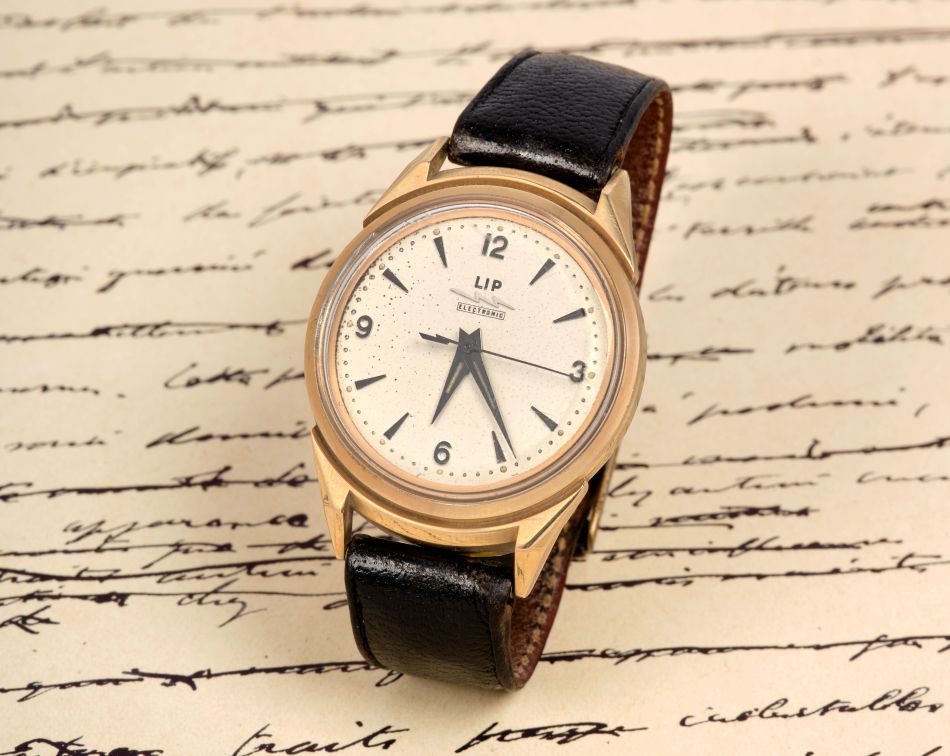
Movement and Complications: Lip watches from the 60s can be classified into two families: mechanical models (manual or automatic) and electric models.
On the mechanical side, Lip produced its own calibers such as the R23 (manual wind, 18,000 vph, a benchmark for reliability) found in the *Himalaya* models, or the R25 (chronometer version of the R23, which equipped a gold Lip also gifted to De Gaulle). Mechanical Lip watches from this era are often simple in complication: a second hand, sometimes a date window (Lip *Dauphine* with R574 date caliber), and that’s it.
On the electric side, the Lip R27 caliber from 1962 is a pioneer: it features a balance wheel powered by a coil and a battery (no traditional escapement) – it’s an ancestor of quartz movements, well before the Japanese quartz era. The *Nautic-Ski* houses a Lip R184 electronic caliber (electromechanical movement with coil) or sometimes R018 (purely mechanical version). Lip also used Swiss movements for certain models (e.g., Lip chronographs from the 60s are powered by Landeron or Valjoux depending on the reference, ensuring robustness and easy maintenance).
One notable complication at Lip in the sixties is the alarm: the 1959 Lip *General de Gaulle* is a mechanical alarm watch (cal. Lip R86) directly competing with the Vulcain Cricket. The 1967 *Nautic-Ski*, on the other hand, introduces the day/night indicator on the dial (half white, half black) coupled with the date, clever for knowing if it’s AM or PM when setting. Also noteworthy are Lip watches with dial illumination**: the Lip *Electronic* later inspired the addition of a small bulb on certain models (Lip *Quartz* 1975).**
In terms of quality, Lip watches from this era shine with their finishes**: often chrome-plated or 20-micron gold-plated cases of good quality, domed dials with neat appliqués, thick plexi crystals. These are watches designed and assembled in France, with true artisanal know-how. Wearing a vintage Lip means wearing a small piece of French watchmaking heritage.**
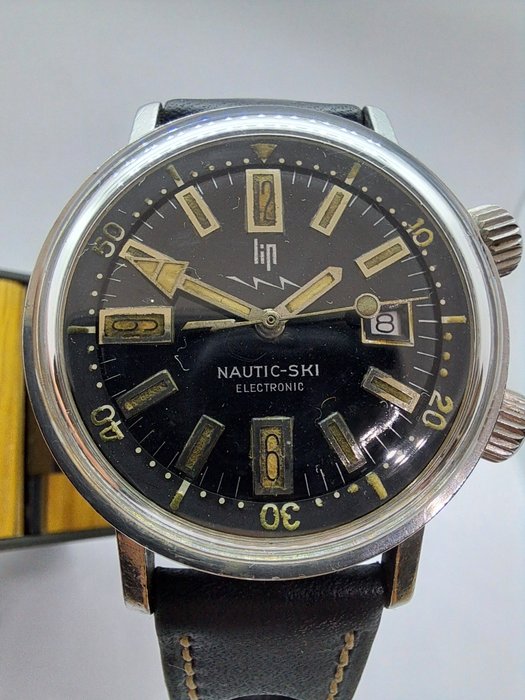
Must-Have References: It’s hard to choose, as Lip offered so many iconic models in the 60s! To start, the Lip *Himalaya*** (1954-1973) is a pillar: a classic watch, 33 to 35mm, 17 jewels, shock-resistant, with numerous variants (steel case, gold-plated, white dial, black, two hands or second hand) found at gentle prices. It’s the « General de Lattre’s watch, » named after the commemorative model released in 1959, embodying simple elegance.**
Another must-have, the Lip *Nautic-Ski*** (1967) – the first French diver – with its 36mm Compressor case and inimitable look, half diver, half dress watch. If your budget allows (value ~€400-€500 today), it’s a must in a French collection.**
Let’s not overlook the Lip *Electronic** (1962-1967): recognizable by the « Electronic » inscription at 6 o’clock, battery-powered, it existed in men’s 35mm and women’s versions. A steel Lip Electronic model in good condition, functional movement, can be worth around €300 (rare, as many suffered from battery corrosion left in place).**
Finally, for sport-chic enthusiasts, Lip offered the *Mariner* and *Nautic* (different from the Nautic-Ski): waterproof watches with colorful designs very typical of the 70s, but we’re straying a bit from our 60s decade. Let’s mention for completeness the Lip *Dauphine*** (late 50s – 60s), an elegant 34mm extra-thin watch, often found for less than €200, whose name evokes the Renault cars of the era – a fine example of Lip’s appeal to the spirit of the times.**
Price Evolution (2025): Vintage Lip watches have seen their value climb in recent years, driven by renewed interest in this brand with a turbulent history (the famous « Lip events » of the 70s left their mark). Nevertheless, budgets remain reasonable compared to Swiss equivalents**. A Lip Himalaya in good condition trades between €150 and €300. An original, complete Nautic-Ski can reach €500 (which is the upper limit of our price ranking), whereas an equivalent Swiss diver would be worth double.**
Lip Electronic models, long shunned because they were difficult to repair, are starting to attract interest: expect €200-€250 for a functional Electronic with its original case. 60s Lip chronographs, however, exceed the « under €500 » scope (a beautiful 1967 Lip Monte-Carlo is worth around €2000 today).
Overall, for an enthusiast, the €200-€500** range already opens up many possibilities at Lip. And the fact that the brand still exists (the current Lip reissues certain pieces) keeps a spotlight on these vintage models, supporting their prices without making them inaccessible. One should view 60s Lip watches as national treasures to adopt while they are still affordable.**
Coherent Alternative: If you like the Lip spirit – technical and elegant – but wish to explore other horizons, turn towards the « forgotten » Swiss watches of the 60s**. For example, an Omega Genève** or a Tissot Seastar Visodate** from the sixties can sometimes be found just under or around €500 and offer an interesting Swiss pedigree. Admittedly, they lack the French touch, but these « mass market » Omega or Tissot watches of the era were often a first step into affordable luxury, much like Lip in France. In a collection, alternating Lip and Tissot can thus create a most instructive Franco-Swiss dialogue.**
5. Vostok Amphibia (1970s) – The Indestructible Soviet Tool
Historical Context and Revolution: 1967, in the midst of the Cold War, the Soviet Ministry of Defense commissioned the Chistopol Watch Factory (Vostok brand) to create a dive watch capable of competing with Western Rolex Submariners and Blancpain Fifty Fathoms. Problem: the USSR lacked the machinery to copy these Swiss watches, and patents prevented any slavish reproduction.
No matter: engineers Mikhail Novikov and Vera Belova designed a completely original diver from scratch, adapted to local production means. Thus, the Vostok Amphibia was born.
Revolutionary it is, in its technical approach: instead of fighting water pressure through sheer robustness (like the Swiss), they decided to use it to their advantage.
How? By equipping the Amphibia with a thick, domed plexiglass crystal that deforms slightly under pressure: the deeper the watch goes, the more the crystal and case back compress the gasket, improving water resistance. It’s the opposite of traditional watches! Furthermore, the Amphibia’s case back is a two-part system (a back and a screw-down ring) which also allows the back to move slightly and better crush the gasket under pressure.
The result: as early as 1967, Vostok offered a diver guaranteed to 200m, reliable and inexpensive – a feat in the Soviet context. This watch would equip sailors, divers, and even cosmonauts: in 1975, cosmonaut Georgy Grechko went into space on Soyuz-17 with his Vostok Amphibia on his wrist, proving absolute confidence in this robust timepiece. The Amphibia is somewhat the *Jeep* of watches: rustic, without ostentatious luxury, but capable of enduring anything.
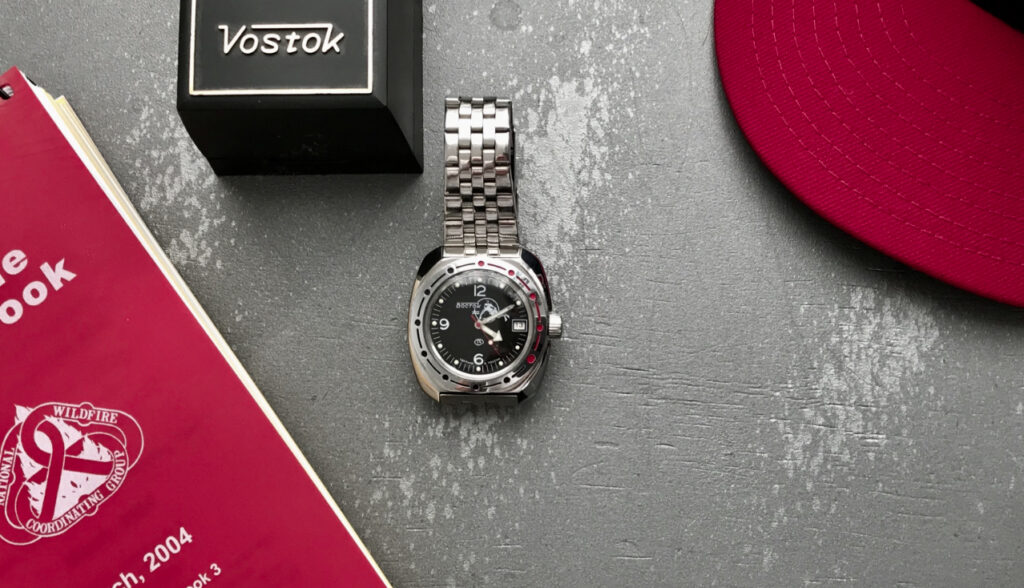
Movement and Features: The Amphibia is powered by a Vostok 2416 automatic caliber (31 jewels) or its 17-jewel manual variants (cal. 2415) – simple movements, beating at 19,800 vph, known for their high winding torque and their unidirectional oscillating weight identifiable by a soft clicking sound. No superfluous complications here: three hands, sometimes the date, and that’s all.
The crown is screw-down but in a peculiar way: it’s mounted on a spring, so in the screwed position, it doesn’t press on the stem (preserving the gasket and threads from shocks). This « wobbly » crown system gives a floating impression when unscrewed – a distinctive trait of Vostoks.
70s Amphibia dials often feature playful motifs: the famous « Scuba Dude » (diver with harpoon) on a blue background, the Amphibia « Radio Room » with red radio silence markings, or military dials (red star, submarine, paratrooper…).
The case, in stainless steel or chrome-plated brass, comes in multiple shapes: classic round (Type 350), octagonal, cushion, etc. All share the knurled rotating bezel that is non-clicking (it turns freely in both directions, as it was initially designed as a simple dive duration marker). This bezel, often chrome-plated brass on older models, develops a nice patina over time.
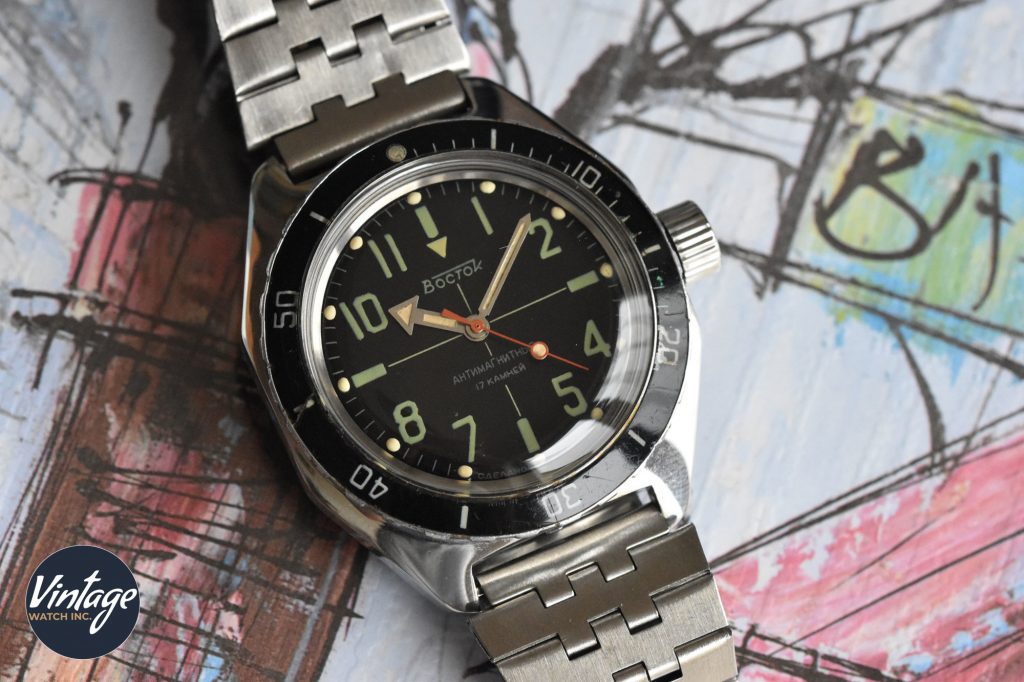
In terms of feel, the Amphibia surprises with its lightness (chrome-plated case versions are quite light compared to all-steel Swiss divers) and its somewhat *raw* aspect. It’s a true tool watch, designed to be produced quickly and function everywhere: from the Afghan desert to the icy waters of the Arctic. Its design, both utilitarian and quirky (with those colorful dials), makes it an endearing watch for collectors seeking something other than yet another Rolex homage.
Must-Have References: Officially, Vostok didn’t name its models like Western brands do, but collectors have identified case shapes and popular nicknames. The Amphibia Type 350 (classic 41mm round case) and Type 710 « Ministry » (39mm cushion case, so called because it was believed to be reserved for ministries) are among the most sought-after.
Dial-wise, the blue « Scuba Dude » is a must, as is the dial with a Red Star and « ЗАКАЗ МО СССР » inscription (Order of the Ministry of Defense) found on some limited series for the military, similar to the Komandirskie. Ah, let’s talk about the Komandirskie: if the Amphibia is the diver, the Vostok Komandirskie is the standard military watch (non-diver, 17 jewels, 30m water-resistant). Many Amphibia dials were also offered in Komandirskie versions and vice versa.
A beginner collector would thus benefit from looking at these Komandirskies as well: they cost even less and share 80% of the components. In short, the Amphibia must-haves boil down to a matter of taste (case shape, dial motif) rather than a specific reference. The advantage: one can collect several without breaking the bank.
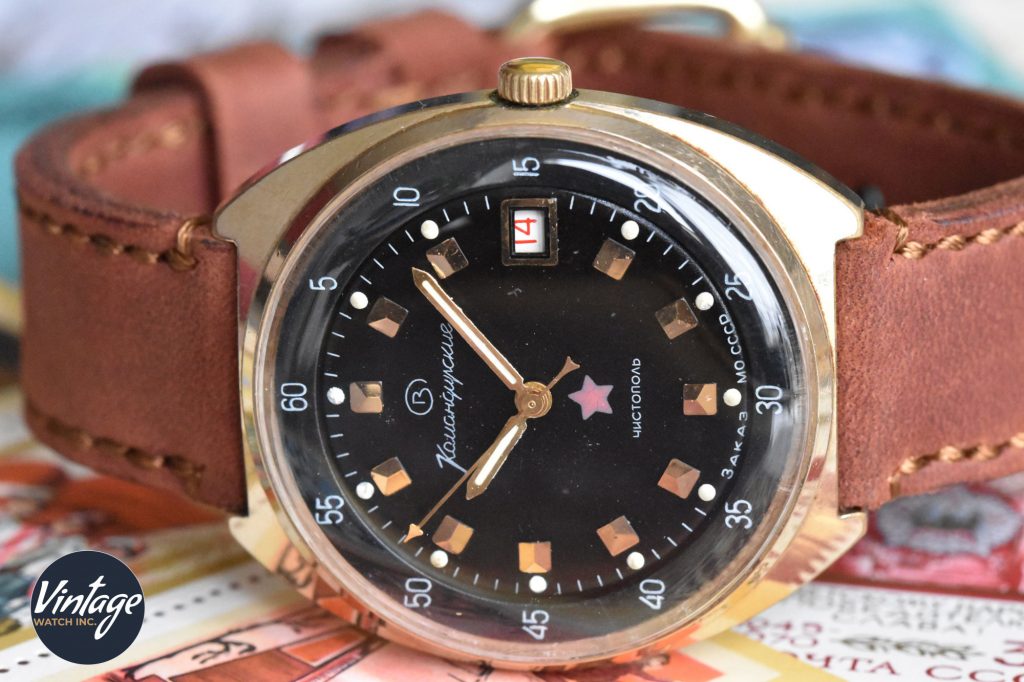
Price Evolution (2025): Soviet watches were long considered cheap curiosities – and this is still reflected in the prices. An authentic vintage Amphibia can be found for around €70 to €150 depending on the model and condition. There are still unsold stocks from the 80s-90s, sold as « NOS » online for a hundred euros at most.
The fact that Vostok still produces the model (new around €80) also keeps vintage prices at a floor level. However, some rare dials have recently sold for over €200 among collectors (e.g., the *Desert Shield* Amphibia, a special export edition from the 90s). But this remains the exception.
Overall, with €500 in hand in 2025, one could buy 3 or 4 different vintage Amphibias**! Enough to start a thematic collection (e.g., one per case type) without worry. It should also be noted that spare parts (movements, crowns) are available new for a few euros via resellers, which is reassuring when buying: a breakdown is not dramatic, the movement can be replaced or repaired very cheaply. The Amphibia remains true to its vocation as a utility tool: **accessible and indestructible**.
Hunt for your Vostok Amphibia on Catawiki (Soviet robustness at gentle prices, watch the auctions).
Coherent Alternative: To stay in the spirit of affordable « vintage tool watches, » one could consider the Citizen *Parawater*** from the 60s – the first Japanese diver waterproof to 100m, contemporary to the Amphibia (and launched as early as 1959, with another innovative water resistance concept). Although rarer, a Citizen Parawater or a 1970 Citizen *Challenge Diver* (famous for surviving 6 months at the bottom of the ocean!) can sometimes be found around €400-€500. They offer a Japanese alternative to Soviet solutions, with a slightly more conventional design but an equally rich history. In any case, the idea here is that there’s a whole world of **non-Swiss** vintage dive watches to explore on a reasonable budget.
Comparative Table of the 5 Selected Watches
To recap and help you compare these five must-haves at a glance, here is a summary table grouping their main features:
| Model | Era (production) | Movement | Diameter | Complications | Price 2025 (approximate) |
|---|---|---|---|---|---|
| Seiko 5 (Sportsmatic / 5 Sports) | 1963 – 1970s (cont. prod.) | Automatic 17/21 jewels (cal. 61xx, 63xx…) | 36-40mm | Day + Date | €50 – €150 |
| Timex Marlin | 1960s – 1970s | Manual (some auto late 70s) – Timex pin-lever escapement | 34-36mm | Date (on some models) | €50 – €150 |
| Orient 3 Stars / King Diver | 1960s – 1970s | Automatic 21 jewels (cal. Orient 469) | 35-43mm | Day + Date, GMT* (depending on model) | €80 – €250 |
| LIP Himalaya / Nautic | 1950s – 1960s | Manual 17 jewels (cal. Lip R23) or Electronic (R27) | 33-36mm | Date, Alarm* (depending on model) | €150 – €500 |
| Vostok Amphibia | 1970s (from 1967) | Automatic 31 jewels (cal. 2416) or manual 17 jewels | 38-41mm | Date (on some) | €70 – €150 |
*GMT = second time zone, Alarm = alarm function. (Indicative price ranges correspond to watches in good condition, excluding exceptionally rare collector’s items.)
Buying Tips for a Good Start (Authentication, Pitfalls, Good Addresses)
Buying a vintage watch can seem intimidating at first. Here are some proven tips to build this collection without unpleasant surprises:
- Prefer reputable sellers: specialized forums (like Chronomania, WatchUseek internationally), Facebook collector groups, or auction platforms with review systems (eBay, Catawiki). On forums, don’t hesitate to ask for an evaluation of an ad before buying: the enthusiast community is usually happy to help authenticate a model or point out an overpriced item.
- Learn to spot signs of authenticity: each model has its characteristics. For example, a vintage Seiko 5 must have a caliber and case number engraved on the back (not just « Water Resist »). Timex Marlins generally don’t have a red central second hand – beware of overly flamboyant repainted dials. For Lip, a serial number is often engraved inside the case back. Consult online resources (specialized sites, period catalogs) to compare the coveted example with an official model.
- Dial and movement condition: for vintage, it’s better to prioritize an original dial with its patina (even if it has some spots or signs of aging) rather than a freshly repainted dial. An original dial, even imperfect, preserves the watch’s value. Regarding the movement, ideally ask for a photo of the caliber. A trustworthy seller won’t object. This allows you to check for all parts, absence of excessive corrosion, etc. For Lip electronic movements, ensure the watch doesn’t have a leaked battery inside (a classic plague, so beware of « untested » watches – often synonymous with a battery forgotten for 40 years…).
- Service and maintenance: Budget for a small service by a watchmaker for mechanical models, especially if they haven’t run for a long time. Simple lubrication and cleaning can give an old watch a second life for a few tens of euros. For simpler calibers (Timex pin-lever, Vostok), many collectors even learn to do it themselves – but it’s not mandatory. Just remember that a vintage watch needs maintenance, much like a classic car.
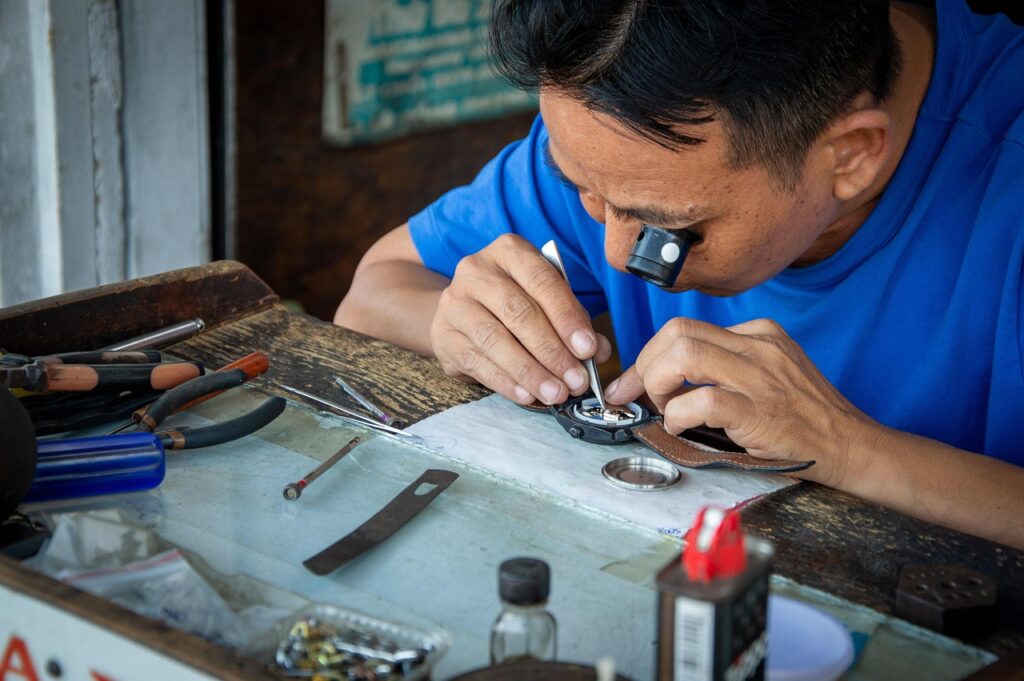
- Common pitfalls: Beware of so-called *Frankenstein* watches, especially for Seiko and Vostok – an assembly of parts from various sources to make a watch « look » complete. For example, an Amphibia with a modern dial in an old case, or a Seiko 5 with a dial from a different model. This might be tempting because it’s cheap, but the collector value and durability can suffer (poorly fitted parts, etc.). Likewise, watch out for fake signatures: some Lip Electronics were counterfeited in the 70s (ironically, by the USSR which produced « Lip » without a license!). Fortunately, these cases remain marginal for our five chosen models, as their low resale value limits counterfeiters’ interest. Still, remain vigilant and do your homework.
- Good addresses: In addition to forums, some sites specialize in selling vintage watches at gentle prices. Internationally, the *Chrono24* platform is full of sub-€500 watches – use the filters by price and era. Finally, don’t forget flea markets and garage sales: finding a Seiko or Lip at the bottom of a drawer for a few euros isn’t an urban legend, it still happens. Arm yourself with a magnifying glass and patience, and the treasures will find you.
In conclusion, starting a vintage watch collection on a reasonable budget is an exciting and entirely achievable adventure. From Japanese Seiko 5s to French Lips, through robust American Timexes, one can build an eclectic collection of five historic watches without exceeding €500 per piece – and even much less for some.
Each watch will tell a story: that of the democratization of the automatic, of marketing audacity, technical innovation, or military ingenuity. And above all, each will bring that indescribable vintage charm: the patina of time, the tick-tock of the mechanical caliber wound while thinking of those who wore it before us.
By following the buying tips and taking the time to choose, you will soon have on your wrist (and in your box) something to admire the passing time with style and pride. Welcome to the wonderful world of vintage watchmaking!
